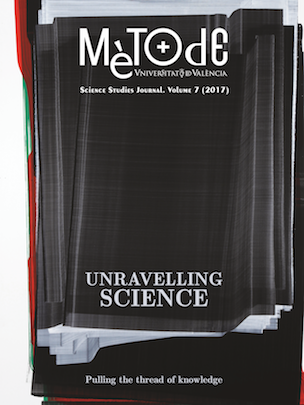Ghost particles in the universe: Neutrinos in astrophysics and cosmology
DOI:
https://doi.org/10.7203/metode.7.8507Paraules clau:
neutrinos, dark matter, supernova, flavor oscillations, astroparticle physics Resum
Resum
Neutrinos are nearly massless and very difficult to detect because they interact so very weakly. Sixty years after seeing the first of these «ghost particles» we know a lot about their properties. Today, observing them in nuclear reactors, the Sun, the Earth’s crust and atmosphere, and at high energies from distant cosmic sources is almost a routine task – they have become unique astrophysical messengers. They are important for a number of aspects: neutrinos shape some of the most dramatic astrophysical phenomena in the form of stellar-collapse supernova explosions, they may have created the excess of matter over antimatter in the universe, and neutrino-like «weakly interacting massive particles» may well account for the dark matter of the universe.
 Descàrregues
Descàrregues
 Referències
Referències
Bertone, G. (Ed.). (2010). Particle dark matter: Observations, models and searches. Cambridge: University Press.
Bilenky, S. (2010). Introduction to the physics of massive and mixed neutrinos. Lecture Notes in Physics, 817, 1–255. doi: 10.1007/978-3-642-14043-3
Buchmüller, W., Di Bari, P., & Plümacher, M. (2005). Leptogenesis for pedestrians. Annals of Physics, 315, 305–351. doi: 10.1016/j.aop.2004.02.003
Dell’Oro, S., Marcocci, S., Viel, M., & Vissani, F. (2016). Neutrinoless double beta decay: 2015 Review. Advances in High Energy Physics, 2162659. doi: 10.1155/2016/2162659
UNE Collaboration. (2015). Long-baseline neutrino facility (LBNF) and deep underground neutrino experiment (DUNE). Conceptual design report. Volume 2: The Physics Program for DUNE at LBNF. Retrieved from http://arXiv.org/abs/1512.06148
Gariazzo, S., Giunti, C., & Laveder, M. (2016). Neutrino unbound. Retrieved from http://www.nu.to.infn.it/
Horowitz, C. J., Coakley, K. J., & McKinsey, D. N. (2003). Supernova observation via neutrino-nucleus elastic scattering in the CLEAN detector. Physical Review D, 68, 023005. doi: 10.1103/PhysRevD.68.023005
Hyper-Kamiokande Proto-Collaboration. (2015). Physics potential of a long-baseline neutrino oscillation experiment using a J-PARC neutrino beam and Hyper-Kamiokande. Progress of Theoretical and Experimental Physics, 053C02. doi: 10.1093/ptep/ptv061
IceCube Collaboration. (2013). First observation of PeV-energy neutrinos with IceCube. Physical Review Letters, 111, 021103. doi: 10.1103/PhysRevLett.111.021103
Janka, H.-T. (2012). Explosion mechanisms of core-collapse supernovae. Annual Review of Nuclear and Particle Science, 62, 407–451. doi: 10.1146/annurev-nucl-102711-094901
JUNO Collaboration. (2016). Neutrino physics with JUNO. Journal of Physics G: Nuclear and Particle Physics, 43, 030401. doi: 10.1088/0954-3899/43/3/030401
Koshiba, M. (1992). Observational neutrino astrophysics. Physics Reports, 220, 229–381. doi: 10.1016/0370-1573(92)90083-C
Mirizzi, A., Tamborra, I., Janka, H.-T., Saviano, N., Scholberg, K., Bollig, R., … Chakraborty, S. (2016). Supernova neutrinos: Production, oscillations and detection. La Rivista del Nuovo Cimento, 39, 1–112. doi: 10.1393/ncr/i2016-10120-8
Scholberg, K. (2012). Supernova neutrino detection. Annual Review of Nuclear and Particle Science, 62, 81–103. doi: 10.1146/annurev-nucl-102711-095006
Villaescusa-Navarro, F., Bull, P., & Viel, M. (2015). Weighing neutrinos with cosmic neutral hydrogen. Astrophysical Journal, 814, 146–165. doi: 10.1088/0004-637X/814/2/146
Descàrregues
Publicades
Com citar
-
Resum975
-
PDF 343
Número
Secció
Llicència
![]()
Tots els documents inclosos en OJS són d'accés lliure i propietat dels seus autors.
Els autors que publiquen en aquesta revista estan d'acord amb els següents termes:
- Els autors conserven els drets d'autor i garanteixen a la revista el dret a la primera publicació del treball, llicenciat baix una llicència de Reconeixement-NoComercial-SenseObraDerivada 4.0 Internacional de Creative Commons, que permet a altres compartir el treball amb un reconeixement de l'autoria del treball i citant la publicació inicial en aquesta revista.
- Es permet i s'anima els autors a difondre la versió definitiva dels seus treballs electrònicament a través de pàgines personals i institucionals (repositoris institucionals, pàgines web personals o perfils a xarxes professionals o acadèmiques) una vegada publicat el treball.





